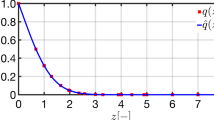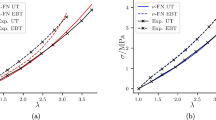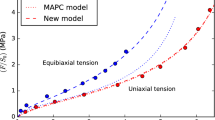Abstract
In physically (statistically) based theories for rubber-like materials, network models serve as a bridge that connects chain dynamics to continuum constitutive relations. However, there is no existing network model that accounts for the size-dependent mechanical properties of nano/microsize polymeric structures. The present work aims to fill this gap and derive a physically based strain gradient continuum. To establish a quantitative relation between the microscopic Helmholtz free energy due to polymer chain stretch and the macroscopic counterpart that depends on all details of the strain field, we connect strain and strain gradient measures to the positions of all chain ends. Taking the continuum displacement field to be interpolatory at the chain ends, a general framework is constructed, which is not restricted to any specific network structure. Applying the general framework to the commonly used 8-chain network model, we derive a first-order strain gradient elastic continuum, where size of the representative network turns out to be the characteristic length scale of strain gradient material. According to the scalar invariants of strain gradient tensor that remain at last, the assumption of parameter reduction in the simplified strain gradient elasticity theory is justified.




Similar content being viewed by others
Notes
Note that in the original work proposing the “8-chain” network [12], Langevin statistics is used to account for limited extendability. However, in the present work, we focus on large strain gradients instead of large finite strain, and thus the Gaussian statistics renders accurate.
This is a lengthy calculation, simplified by non-dimensionalization to some extent.
References
Marckmann, G., Verron, E.: Comparison of hyperelastic models for rubber-like materials. Rubber Chem. Technol. 79(5), 835–858 (2006)
Manias, E., Chen, J., Fang, N., Zhang, X.: Polymeric micromechanical components with tunable stiffness. Appl. Phys. Lett. 79(11), 1700–1702 (2001)
Lam, D.C., Yang, F., Chong, A., Wang, J., Tong, P.: Experiments and theory in strain gradient elasticity. J. Mech. Phys. Solids 51(8), 1477–1508 (2003)
Rubinstein, M., Colby, R.H., et al.: Polymer physics, vol. 23. Oxford University Press, New York (2003)
Treloar, L.G.: The physics of rubber elasticity
Treloar, L.: Stress-strain data for vulcanized rubber under various types of deformation. Rubber Chem. Technol. 17(4), 813–825 (1944)
Wall, F.T.: Statistical thermodynamics of rubber. II. J. Chem. Phys. 10(7), 485–488 (1942)
Boyce, M.C., Arruda, E.M.: Constitutive models of rubber elasticity: a review. Rubber Chem. Technol. 73(3), 504–523 (2000)
Wang, M.C., Guth, E.: Statistical theory of networks of non-Gaussian flexible chains. J. Chem. Phys. 20(7), 1144–1157 (1952)
Treloar, L.: The elasticity of a network of long-chain molecules-III. Trans. Faraday Soc. 42, 83–94 (1946)
Flory, P..J., Rehner, J., Jr.: Statistical mechanics of cross-linked polymer networks I rubberlike elasticity. J. Chem. Phys. 11(11), 512–520 (1943)
Arruda, E.M., Boyce, M.C.: A three-dimensional constitutive model for the large stretch behavior of rubber elastic materials. J. Mech. Phys. Solids 41(2), 389–412 (1993)
Miehe, C., Göktepe, S., Lulei, F.: A micro-macro approach to rubber-like materials-part I: the non-affine micro-sphere model of rubber elasticity. J. Mech. Phys. Solids 52(11), 2617–2660 (2004)
Miehe, C., Göktepe, S.: A micro–macro approach to rubber-like materials. part II: The micro-sphere model of finite rubber viscoelasticity. J. Mech. Phys. Solids 53(10), 2231–2258 (2005)
Göktepe, S., Miehe, C.: A micro-macro approach to rubber-like materials. Part III: The micro-sphere model of anisotropic Mullins-type damage. J. Mech. Phys. Solids 53(10), 2259–2283 (2005)
Mindlin, R.D.: Second gradient of strain and surface-tension in linear elasticity. Int. J. Solids Struct. 1(4), 417–438 (1965)
Mindlin, R.D., Eshel, N.: On first strain-gradient theories in linear elasticity. Int. J. Solids Struct. 4(1), 109–124 (1968)
Yang, F., Chong, A., Lam, D.C.C., Tong, P.: Couple stress based strain gradient theory for elasticity. Int. J. Solids Struct. 39(10), 2731–2743 (2002)
Eringen, A.C., Edelen, D.: On nonlocal elasticity. Int. J. Eng. Sci. 10(3), 233–248 (1972)
Eringen, A.C.: Nonlocal Continuum Field Theories. Springer, New York (2002)
Eringen, A.C.: Microcontinuum Field Theories: I. Foundations and Solids. Springer, New York (2012)
Germain, P.: The method of virtual power in continuum mechanics. Part 2: Microstructure. SIAM J. Appl. Math. 25(3), 556–575 (1973)
Srinivasa, A.R., Reddy, J.: An overview of theories of continuum mechanics with nonlocal elastic response and a general framework for conservative and dissipative systems. Appl. Mech. Rev. 69(3)
Rafii-Tabar, H., Ghavanloo, E., Fazelzadeh, S.A.: Nonlocal continuum-based modeling of mechanical characteristics of nanoscopic structures. Phys. Rep. 638, 1–97 (2016)
Reddy, J.: Nonlocal theories for bending, buckling and vibration of beams. Int. J. Eng. Sci. 45(2–8), 288–307 (2007)
Reddy, J.: Nonlocal nonlinear formulations for bending of classical and shear deformation theories of beams and plates. Int. J. Eng. Sci. 48(11), 1507–1518 (2010)
Ghosh, S., Kumar, A., Sundararaghavan, V., Waas, A.M.: Non-local modeling of epoxy using an atomistically-informed kernel. Int. J. Solids Struct. 50(19), 2837–2845 (2013)
Khodabakhshi, P., Reddy, J.: A unified integro-differential nonlocal model. Int. J. Eng. Sci. 95, 60–75 (2015)
Lim, C., Zhang, G., Reddy, J.: A higher-order nonlocal elasticity and strain gradient theory and its applications in wave propagation. J. Mech. Phys. Solids 78, 298–313 (2015)
Zhou, S., Li, A., Wang, B.: A reformulation of constitutive relations in the strain gradient elasticity theory for isotropic materials. Int. J. Solids Struct. 80, 28–37 (2016)
Forest, S.: Homogenization methods and mechanics of generalized continua-part 2. Theor. Appl. Mech. 28–29, 113–144 (2002)
Bacca, M., Bigoni, D., Dal Corso, F., Veber, D.: Mindlin second-gradient elastic properties from dilute two-phase Cauchy-elastic composites. Part I: Closed form expression for the effective higher-order constitutive tensor. Int. J. Solids Struct. 50(24), 4010–4019 (2013)
Bacca, M., Bigoni, D., Dal Corso, F., Veber, D.: Mindlin second-gradient elastic properties from dilute two-phase Cauchy-elastic composites part II: Higher-order constitutive properties and application cases. Int. J. Solids Struct. 50(24), 4020–4029 (2013)
Hütter, G.: Homogenization of a Cauchy continuum towards a micromorphic continuum. J. Mech. Phys. Solids 99, 394–408 (2017)
Alavi, S., Ganghoffer, J., Reda, H., Sadighi, M.: Construction of micromorphic continua by homogenization based on variational principles. J. Mech. Phys. Solids 153, 104278 (2021)
Admal, N.C., Marian, J., Po, G.: The atomistic representation of first strain-gradient elastic tensors. J. Mech. Phys. Solids 99, 93–115 (2017)
Maranganti, R., Sharma, P.: A novel atomistic approach to determine strain-gradient elasticity constants: Tabulation and comparison for various metals, semiconductors, silica, polymers and the (ir) relevance for nanotechnologies. J. Mech. Phys. Solids 55(9), 1823–1852 (2007)
Altan, B., Aifantis, E.: On some aspects in the special theory of gradient elasticity. J. Mech. Behav. Mater. 8(3), 231–282 (1997)
Gao, X.-L., Park, S.: Variational formulation of a simplified strain gradient elasticity theory and its application to a pressurized thick-walled cylinder problem. Int. J. Solids Struct. 44(22–23), 7486–7499 (2007)
Gitman, I.M., Askes, H., Aifantis, E.C.: The representative volume size in static and dynamic micro-macro transitions. Int. J. Fract. 135(1), L3–L9 (2005)
Khakalo, S., Balobanov, V., Niiranen, J.: Modelling size-dependent bending, buckling and vibrations of 2D triangular lattices by strain gradient elasticity models: applications to sandwich beams and auxetics. Int. J. Eng. Sci. 127, 33–52 (2018)
Khakalo, S., Niiranen, J.: Form II of Mindlin’s second strain gradient theory of elasticity with a simplification: for materials and structures from nano-to macro-scales. European Journal of Mechanics-A/Solids 71, 292–319 (2018)
Solyaev, Y.: Self-consistent assessments for the effective properties of two-phase composites within strain gradient elasticity. Mech. Mater. 104321 (2022)
Gurtin, M.E., Fried, E., Anand, L.: The Mechanics and Thermodynamics of Continua. Cambridge University Press, Cambridge (2010)
Li, L., Tang, H., Hu, Y.: The effect of thickness on the mechanics of nanobeams. Int. J. Eng. Sci. 123, 81–91 (2018)
Tang, H., Li, L., Hu, Y.: Coupling effect of thickness and shear deformation on size-dependent bending of micro/nano-scale porous beams. Appl. Math. Model. 66, 527–547 (2019)
Tang, H., Li, L., Hu, Y., Meng, W., Duan, K.: Vibration of nonlocal strain gradient beams incorporating Poisson’s ratio and thickness effects. Thin-Walled Struct. 137, 377–391 (2019)
Lazopoulos, K., Lazopoulos, A.: Bending and buckling of thin strain gradient elastic beams. Eur. J. Mech.-A/Solids 29(5), 837–843 (2010)
Li, L., Lin, R., Hu, Y.: Cross-section effect on mechanics of nonlocal beams. Arch. Appl. Mech. 91(4), 1541–1556 (2021)
Li, L., Lin, R., Ng, T.Y.: Contribution of nonlocality to surface elasticity. Int. J. Eng. Sci. 152, 103311 (2020)
Lin, Z., Wei, Y.: A strain gradient linear viscoelasticity theory. Int. J. Solids Struct. 203, 197–209 (2020)
Niiranen, J., Balobanov, V., Kiendl, J., Hosseini, S.: Variational formulations, model comparisons and numerical methods for Euler-Bernoulli micro-and nano-beam models. Math. Mech. Solids 24(1), 312–335 (2019)
Korshunova, N., Alaimo, G., Hosseini, S., Carraturo, M., Reali, A., Niiranen, J., Auricchio, F., Rank, E., Kollmannsberger, S.: Bending behavior of octet-truss lattice structures: modelling options, numerical characterization and experimental validation. Mater. Design 205, 109693 (2021)
Papargyri-Beskou, S., Tsepoura, K., Polyzos, D., Beskos, D.: Bending and stability analysis of gradient elastic beams. Int. J. Solids Struct. 40(2), 385–400 (2003)
Lurie, S., Solyaev, Y.: Revisiting bending theories of elastic gradient beams. Int. J. Eng. Sci. 126, 1–21 (2018)
Lurie, S., Solyaev, Y.: On the formulation of elastic and electroelastic gradient beam theories. Continuum Mech. Thermodyn. 31(6), 1601–1613 (2019)
Acknowledgements
This work is supported by the National Natural Science Foundation of China (Grant No. 52175095) and the Young Top-notch Talent Cultivation Program of Hubei Province, China.
Author information
Authors and Affiliations
Corresponding authors
Additional information
Publisher's Note
Springer Nature remains neutral with regard to jurisdictional claims in published maps and institutional affiliations.
Rights and permissions
About this article
Cite this article
Jiang, Y., Li, L. & Hu, Y. Strain gradient elasticity theory of polymer networks. Acta Mech 233, 3213–3231 (2022). https://doi.org/10.1007/s00707-022-03280-w
Received:
Revised:
Accepted:
Published:
Issue Date:
DOI: https://doi.org/10.1007/s00707-022-03280-w




